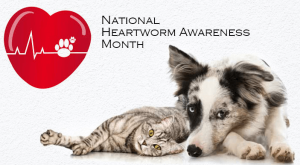Winter Care for Pets: How to Keep Your Furry Friends Safe and Cozy
 As temperatures drop and the winter season settles in, it’s important to ensure your pets are prepared for the cold weather ahead. At Olsen Veterinary Clinic, we want to help you protect your four-legged family members throughout these chilly months. From safe outdoor practices to holiday hazards, we’ve gathered some essential tips to keep your pets healthy, warm, and happy all winter long.
As temperatures drop and the winter season settles in, it’s important to ensure your pets are prepared for the cold weather ahead. At Olsen Veterinary Clinic, we want to help you protect your four-legged family members throughout these chilly months. From safe outdoor practices to holiday hazards, we’ve gathered some essential tips to keep your pets healthy, warm, and happy all winter long.
Bundle Up for Outdoor Time
Even pets with thick fur can feel the effects of winter.
🐾 Limit time outside — Prolonged exposure to cold temperatures can lead to hypothermia or frostbite. Quick walks and supervised play are best.
🐾 Dress for the weather — Short-haired dogs may need sweaters or jackets to retain body heat.
🐾 Protect the paws — Salt, ice, and cold pavement can irritate paw pads. Booties or pet-safe balms can help shield sensitive feet.
🐾 Wipe down after walks — Rock salt and antifreeze are toxic! Clean paws and bellies to stop pets from licking dangerous chemicals.
Create a Cozy Indoor Environment
Winter is the perfect time to make things warm and comfortable for your pets.
🔥 Provide warm bedding — Keep beds off cold floors and away from drafts.
🍽️ Stay on top of nutrition — Some pets may burn more calories staying warm. Ask us if diet adjustments are needed.
💧 Hydrate — Pets can dehydrate in winter, too! Ensure access to fresh, unfrozen water.
🐶 Keep them active — Indoor play, puzzle toys, and short training sessions help prevent winter boredom.
Holiday Safety Tips
The festive season can bring some unexpected risks for pets.
🎄 Decorations with caution
Tinsel, ribbons, and ornaments can be choking hazards. Keep cords and candles out of reach.
🍫 Watch what they eat
Chocolate, holiday sweets, table scraps, and alcohol are dangerous for pets. Remind guests not to feed your furry friends.
🌱 Avoid toxic plants
Mistletoe, holly, and certain types of lilies can be harmful if chewed or ingested.
🎁 Safe gift-giving
Opt for pet-friendly chew toys and avoid items that could splinter or break apart easily.
Car Safety Still Matters
Cold weather doesn’t eliminate vehicle dangers.
🚗 Never leave pets unattended in vehicles
Cars can act like refrigerators, rapidly dropping to unsafe temperatures.
🐱 Check before you drive
Outdoor cats may seek warmth under your car. Tap the hood to be sure no one is hiding near the engine.
Schedule a Winter Wellness Check
Cold weather can aggravate arthritis, respiratory concerns, and other chronic conditions. A seasonal check-up at Olsen Veterinary Clinic can help ensure your pet is ready for winter.
We’re Here for You All Season Long
If you ever notice signs of frostbite, hypothermia, or sudden behavior changes, contact Olsen Veterinary Clinic right away. Winter can be a fun and cozy time for pets—with the right precautions in place!
📞 Call us today to schedule your winter wellness visit
🐾 Your pet’s health and comfort are our top priority.
Thanksgiving with Pets: The Do’s and Don’ts for Holiday Meals
 Thanksgiving is a time for gratitude, family, and of course, delicious food! While we love to include our furry friends in the celebration, it’s important to remember that not everything on the holiday table is safe for pets. At Olsen Veterinary Clinic, we want to help you and your pets enjoy a happy and healthy Thanksgiving together.
Thanksgiving is a time for gratitude, family, and of course, delicious food! While we love to include our furry friends in the celebration, it’s important to remember that not everything on the holiday table is safe for pets. At Olsen Veterinary Clinic, we want to help you and your pets enjoy a happy and healthy Thanksgiving together.
🐾 The Do’s: Safe Ways to Include Your Pets in the Feast
✅ Do share in moderation.
Small, plain portions of pet-safe foods can be a fun treat. Turkey meat (without skin or seasoning), plain green beans, carrots, or pumpkin puree are all healthy options — just keep portions small.
✅ Do keep their routine.
The excitement of guests and new smells can be stressful for pets. Stick to your pet’s regular feeding and walking schedule to keep them calm and comfortable throughout the day.
✅ Do create a quiet space.
If you’re hosting a large gathering, give your pet a quiet room to retreat to with their bed, water, and toys. This helps prevent anxiety and keeps them out of the kitchen chaos.
✅ Do secure the trash.
Thanksgiving leftovers can be tempting, but bones, string, and food wrappers can cause serious harm if swallowed. Make sure the trash is pet-proof and taken out promptly.
🚫 The Don’ts: Foods and Habits to Avoid
❌ Don’t feed turkey bones or skin.
Bones can splinter and cause choking or internal injuries. The skin is high in fat and may lead to pancreatitis, a painful and dangerous condition for dogs and cats.
❌ Don’t give foods with onions, garlic, or chives.
These ingredients, common in stuffing and gravy, are toxic to both dogs and cats and can cause serious digestive and blood problems.
❌ Don’t let them nibble on desserts.
Chocolate, xylitol (found in sugar-free treats), raisins, and grapes are all toxic to pets. Even a small amount can cause severe illness.
❌ Don’t forget about alcohol.
Even small sips of beer, wine, or cocktails can be dangerous for pets. Keep all drinks out of reach.
🐶 A Happy, Healthy Holiday
Thanksgiving can be a joyful experience for you and your pets when you plan ahead. Offer pet-safe treats, keep the dangerous foods off their plates, and stick to routines that make them feel secure.
If your pet gets into something they shouldn’t, contact Olsen Veterinary Clinic right away or reach out to the nearest emergency veterinary service. Quick action can make all the difference.
From all of us at Olsen Veterinary Clinic, we wish you and your furry family members a safe and wonderful Thanksgiving!
Dr. Olsen’s Breed Spotlight: Abyssinian Cats: Elegant, Energetic, and Endlessly Engaging
 Abyssinian cats are one of the oldest known domesticated breeds, admired for their sleek appearance, inquisitive nature, and lively personality. At Olsen Veterinary Clinic, we love helping families understand what makes this breed unique and how to give them the best possible care.
Abyssinian cats are one of the oldest known domesticated breeds, admired for their sleek appearance, inquisitive nature, and lively personality. At Olsen Veterinary Clinic, we love helping families understand what makes this breed unique and how to give them the best possible care.
A Glimpse into Their History and Domestication
While the exact origins of the Abyssinian are still debated, many believe the breed traces back to ancient Egypt. Their elegant, ticked coat and overall appearance resemble the cats seen in ancient statues and artwork. The modern Abyssinian was further developed in the United Kingdom in the late 19th century after cats were brought back from regions around the Red Sea—possibly Abyssinia (modern-day Ethiopia), which inspired the name.
Over generations of careful breeding, Abyssinians became a distinctly recognized breed known for their striking appearance and animated personality.
Breed Characteristics
Abyssinians are often called the “clowns” or “athletes” of the cat world. They are:
- Active and Playful – Abyssinians rarely sit still. They love to climb, explore, and stay involved in whatever their humans are doing.
- Highly Intelligent – Quick learners and problem-solvers, they enjoy puzzles, toys, and enrichment activities.
- Affectionate but Independent – While they bond strongly with their families, they aren’t typically lap cats. They prefer to participate and observe rather than snuggle for long stretches.
- Striking Appearance – The ticked coat is their signature trait, with each hair featuring multiple color bands. Common coat colors include ruddy, red, blue, and fawn. They have almond-shaped eyes, large ears, and a lean, muscular body.
Specific Needs of the Abyssinian
Because of their intelligence and high energy, Abyssinians thrive with environments that stimulate their body and mind. Some of their key needs include:
1. Mental Enrichment
They get bored easily, so interactive toys, foraging puzzles, and window perches can help prevent destructive behavior.
2. Physical Activity
Abyssinians enjoy climbing and jumping. Cat trees, wall shelves, and tunnels are great outlets for their athletic nature.
3. Social Interaction
They love being part of the household and don’t do well being left alone for long periods. Another friendly pet companion can sometimes help.
4. A Nutritious Diet
Their active lifestyle requires high-quality nutrition to support muscle tone and overall health.
5. Preventive Veterinary Care
Though generally healthy, Abyssinians can be predisposed to dental disease, patellar luxation, and certain kidney issues. Routine checkups are essential.
How to Provide the Best Care
Here are some practical tips to help Abyssinian owners meet their cat’s needs:
- Enrichment & Playtime
Schedule daily interactive play sessions using feather wands, laser pointers, or fetch-style toys. Rotate toys regularly to keep them interesting. - Environmental Set-Up
Offer various levels to climb, scratching posts, hideaways, and window views. They thrive in a dynamic space rather than a static environment. - Companionship
Spend time engaging with your cat daily. If your lifestyle keeps you away for long hours, consider adopting a compatible second pet. - Diet & Hydration
Feed a high-quality diet recommended by your veterinarian. Encourage water intake with fountains or multiple bowls. - Grooming
Their short coat is low-maintenance; weekly brushing usually suffices to remove loose fur. This also strengthens the bond between cat and owner. - Regular Vet Visits
Routine wellness exams allow early detection of health issues. Discuss breed-specific concerns like dental care, hereditary conditions, and bloodwork screenings with your veterinarian.
Is an Abyssinian Right for You?
Abyssinians make wonderful companions for families or individuals who can offer time, stimulation, and affection. They are not a low-energy breed and need a home that appreciates their curiosity, athleticism, and social nature.
If you’re considering an Abyssinian—or already share your life with one—Olsen Veterinary Clinic is here to support you with personalized care, nutrition advice, behavioral guidance, and routine wellness services.
Have questions about caring for an Abyssinian? Contact Olsen Veterinary Clinic today—we’re happy to help you keep your feline friend healthy, active, and thriving!
Celebrating The Responsibility Of Pet Ownership: What It Means to Be a Great Pet Parent
 Responsible Pet Ownership Month is actually in February, but at Olsen Veterinary Clinic, we believe now is the perfect time to reflect on the joy pets bring to our lives—and the responsibilities that come with caring for them. Being a great pet parent goes far beyond providing food and shelter. It means committing to your pet’s health, training, and overall well-being for their entire life.
Responsible Pet Ownership Month is actually in February, but at Olsen Veterinary Clinic, we believe now is the perfect time to reflect on the joy pets bring to our lives—and the responsibilities that come with caring for them. Being a great pet parent goes far beyond providing food and shelter. It means committing to your pet’s health, training, and overall well-being for their entire life.
The Responsibilities of Pet Ownership
1. Prioritizing Healthcare
Routine veterinary care is one of the most important aspects of responsible ownership. Just like people, pets need regular check-ups to stay healthy and catch issues early. Annual wellness exams, vaccinations, parasite prevention, dental care, and senior pet check-ups all play a vital role in ensuring your pet lives a long and happy life. Preventive care not only protects your pet but also helps avoid costly emergencies down the road.
2. Providing Proper Nutrition and Exercise
Feeding your pet a balanced diet appropriate for their age, breed, and health condition is key to maintaining good health. Pairing proper nutrition with regular exercise keeps your pet physically fit and mentally stimulated. Daily walks, playtime, and enrichment activities can help prevent obesity and reduce behavioral issues.
3. Training and Socialization
Good behavior doesn’t happen overnight. Training and socialization are essential for your pet’s safety and happiness. Teaching basic commands, house manners, and positive behavior builds trust and strengthens your bond. Socializing your pet with other animals and people helps prevent fear, anxiety, and aggression, making them a well-adjusted member of the family.
4. Providing Love and Companionship
Pets thrive on love, attention, and companionship. They depend on us not just for their physical needs but also for emotional well-being. Spending quality time together through play, snuggles, or quiet companionship enriches both their life and yours.
5. Commitment for a Lifetime
Welcoming a pet into your home is a lifelong promise. Whether it’s a puppy, kitten, or senior rescue, being a responsible pet parent means committing to their care through all stages of life. This includes adjusting to their changing needs as they age.
The Reward of Responsibility
Responsible pet ownership requires dedication, but the rewards are immeasurable. In return for your care and commitment, pets offer unconditional love, loyalty, and companionship. At Olsen Veterinary Clinic, we are here to support you every step of the way with preventive care, health guidance, and resources to help you be the best pet parent you can be.
Take a moment to reflect on your role as a pet parent and celebrate the bond you share with your furry family members. Together, let’s continue building a world where every pet is healthy, happy, and loved.
Back to School Blues: Helping Pets Adjust to Schedule Changes
 As the summer days wind down and families gear up for a new school year, pets often find themselves facing sudden and unfamiliar changes in their daily routines. The shift from long, playful summer days to quieter, emptier homes can trigger confusion, stress, or even separation anxiety in our furry companions.
As the summer days wind down and families gear up for a new school year, pets often find themselves facing sudden and unfamiliar changes in their daily routines. The shift from long, playful summer days to quieter, emptier homes can trigger confusion, stress, or even separation anxiety in our furry companions.
At Olsen Veterinary Clinic, we understand how schedule changes can impact your pet’s mental and emotional well-being. Just like humans, pets thrive on routine, and any disruption—especially one as significant as the back-to-school transition—can lead to behavioral changes. Fortunately, with a few thoughtful strategies, you can help ease your pet into the new normal.
1. Gradually Adjust the Routine
Before the school year begins, start gradually shifting your pet’s schedule. Begin feeding, walking, and playing with them at times that will align with the new routine. This helps your pet adjust to the change without feeling overwhelmed when it happens all at once.
2. Create a Consistent Daily Schedule
Consistency builds comfort. Try to keep feeding times, potty breaks, and walks as consistent as possible. Even if family members are on the go, assigning pet care responsibilities ensures your pet gets the attention and structure they need each day.
3. Provide Morning and Evening Attention
Your pet may feel lonely during the day, so be sure to give them quality time in the mornings before everyone leaves and again in the evenings when the house is full again. Whether it’s a morning walk or evening cuddle, that bonding time is essential for emotional reassurance.
4. Keep Pets Stimulated While Home Alone
Prevent boredom and anxiety by leaving safe, interactive toys or treat puzzles for your pet. Calming music, pet-safe videos, or a window with a view can also keep them entertained while you’re away.
5. Practice Short Departures
In the weeks leading up to school, practice leaving the house for short periods so your pet gets used to being alone. Gradually increase the time to build your pet’s comfort and confidence with being alone during the day.
6. Consider a Pet Companion or Daycare
If your pet struggles with loneliness, consider introducing a companion (another pet, if feasible) or enrolling them in a trusted pet daycare a few times a week. Socialization and activity can help reduce stress.
7. Watch for Signs of Anxiety
Some pets may develop separation anxiety or other stress-related behaviors. Watch for signs like destructive chewing, excessive barking, accidents in the house, or changes in appetite. If you notice any concerning behaviors, don’t hesitate to contact Olsen Veterinary Clinic for guidance.
8. Use Calming Products if Needed
There are a variety of safe, vet-recommended calming products like pheromone diffusers, anxiety wraps, or natural supplements that may help soothe your pet during this transition. Ask us about what might be best for your furry friend.
The Takeaway:
Going back to school is an exciting time for families, but it can be a challenging adjustment for pets. With a bit of planning and compassion, you can help your pet transition smoothly and continue to feel safe, secure, and loved—even if their favorite humans are suddenly busier than before.
If you have questions about your pet’s behavior or need advice tailored to your pet’s personality, contact us or stop by Olsen Veterinary Clinic. We’re here to help your pet feel their best—no matter the season.
Fireworks and Festivities: Calming Your Pets During Summer Celebrations
 As summer rolls in, so do the celebrations—especially around the 4th of July. While we enjoy fireworks, barbecues, and outdoor festivities, these events can be overwhelming and even frightening for our pets. At Olsen Veterinary Clinic, we understand how stressful loud noises and big gatherings can be for animals, and we want to help you ensure your pets stay calm, safe, and secure during the summer’s loudest holidays.
As summer rolls in, so do the celebrations—especially around the 4th of July. While we enjoy fireworks, barbecues, and outdoor festivities, these events can be overwhelming and even frightening for our pets. At Olsen Veterinary Clinic, we understand how stressful loud noises and big gatherings can be for animals, and we want to help you ensure your pets stay calm, safe, and secure during the summer’s loudest holidays.
Why Are Fireworks So Stressful for Pets?
Dogs, cats, and other animals have much more sensitive hearing than humans. Sudden loud noises like fireworks can be terrifying, triggering anxiety, panic, and even physical symptoms such as trembling, pacing, panting, drooling, or attempts to escape. Some pets may hide, while others may try to flee the noise—resulting in injuries or getting lost.
Tips for Keeping Your Pet Calm and Safe
Here are some veterinarian-approved tips to manage your pet’s anxiety and keep them safe during holiday festivities:
1. Create a Safe Space
Designate a quiet, comfortable area in your home where your pet can retreat when the noise begins. Use blankets, favorite toys, or an article of your clothing to make the space feel secure. Keep windows and curtains closed to reduce noise and flashes of light.
2. Keep Them Indoors
Always keep pets indoors during fireworks displays, even if they’re usually calm or used to being outside. Loud noises can cause even the most laid-back pet to bolt unexpectedly. Make sure doors, gates, and windows are secure.
3. Use Calming Tools
Consider using anxiety-reducing products such as:
- Pheromone diffusers or sprays (like Adaptil or Feliway)
- Calming wraps or vests (such as ThunderShirts)
- Veterinary-approved calming treats or supplements
Ask your veterinarian if a prescription anti-anxiety medication is appropriate for your pet if they have a history of severe noise anxiety.
4. Provide Background Noise
Turn on soft music, a fan, or the television to help mask the sounds of fireworks. The constant background noise can create a soothing environment and minimize the contrast of loud bangs.
5. Exercise Early
Take your dog for a long walk or play an extended session of fetch earlier in the day. A tired pet is more likely to rest and stay calm during the evening festivities.
6. Update ID Tags and Microchips
In the unfortunate event that your pet escapes, having up-to-date ID tags and a registered microchip greatly increases the chances of a safe return home. Make sure collars are snug and secure.
7. Stay Calm Yourself
Pets often pick up on our emotions. If you’re anxious or upset about the fireworks, your pet may become even more stressed. Stay calm and speak to them in a gentle, reassuring tone.
Final Thoughts
Fireworks and festivities are fun for people but often frightening for pets. With preparation and care, you can help your furry friend feel more secure and less anxious. If you have concerns about your pet’s behavior or need help choosing the right calming aid, don’t hesitate to reach out to us at Olsen Veterinary Clinic. We’re here to keep your pets happy, healthy, and safe—during every celebration and beyond.
Wishing you and your pets a safe and stress-free 4th of July!
Summer Safety Tips: Keeping Your Pets Cool and Comfortable

As the temperatures rise and summer sets in, it’s important to remember that the heat can be just as uncomfortable—and even dangerous—for your pets as it is for you. At Olsen Veterinary Clinic, we care deeply about your furry family members and want to ensure they stay safe, happy, and healthy all summer long.
Here are some essential tips and advice for avoiding heat-related illnesses and keeping your pets cool during the summer months:
☀️ Understand the Risks of Heat for Pets
Unlike humans, pets don’t sweat to cool down (aside from a bit through their paws). Dogs mainly cool off by panting, and cats often rely on finding shady, cool areas. But in extreme heat, these natural cooling mechanisms may not be enough.
Heatstroke is a serious, potentially fatal condition in pets. Signs include:
- Excessive panting or drooling
- Rapid heartbeat
- Lethargy or unresponsiveness
- Vomiting or diarrhea
- Bright red or pale gums
If you suspect heatstroke, move your pet to a cool area and contact Olsen Veterinary Clinic immediately at [your clinic phone number].
🌳 Provide Shade and Fresh Water
Whether your pet is indoors or outdoors, make sure they always have access to:
- Fresh, cool water (consider adding ice cubes!)
- Shaded areas if they’re outside—trees, tarps, or doghouses with ventilation
- Cool indoor spots away from direct sunlight
Pro tip: Use a cooling mat or damp towel for your pet to lie on indoors.
🚗 Never Leave Your Pet in a Parked Car
Even with the windows cracked, the temperature inside a parked car can skyrocket in minutes. On an 85°F day, the interior can reach over 100°F in just 10 minutes. This can quickly lead to heatstroke or worse.
Leaving pets in cars is dangerous and potentially deadly. Always take them with you or leave them safely at home.
🐾 Be Mindful of Hot Pavement
If it’s too hot for your bare feet, it’s too hot for your pet’s paws. Asphalt, sand, and concrete can cause painful burns. Walk your dog early in the morning or later in the evening, and consider pet booties for extra protection.
🐕🦺 Exercise Smart
Limit intense exercise during the hottest parts of the day. Opt for short walks, indoor play, or water activities like kiddie pools or sprinklers.
Some breeds—like pugs, bulldogs, and Persian cats—are more prone to heatstroke due to their short noses and breathing difficulties. Take extra care with these pets.
🍦 Cool Treat Ideas
Give your pets a summer treat:
- Frozen dog-safe fruits like watermelon or blueberries
- Ice cubes with treats or peanut butter inside
- Pet-safe frozen yogurt or broth popsicles
Always check ingredients to ensure they’re safe for your specific pet!
🏡 Know Your Pet’s Limits
Every animal is different. Older pets, overweight pets, and those with medical conditions may struggle more with heat. Watch for signs of discomfort and adjust their routines accordingly.
😎 Stay Cool with Olsen Veterinary Clinic
If you have concerns about your pet’s health in the heat, or want personalized advice for your pet this summer, don’t hesitate to contact us. We’re here to help you enjoy the season safely with your furry companions!
Traveling with Pets: Tips for a Stress-Free Vacation
 Vacation season is here, and for many of us, that means bringing our furry companions along for the adventure! Whether you’re hitting the road, taking to the skies, or staying in a cozy pet-friendly hotel, traveling with pets can be a joyful bonding experience—when done right. At Olsen Veterinary Clinic, we want your travels to be as smooth and stress-free as possible for both you and your pets. Here are some essential tips to keep in mind for car rides, flights, and accommodations.
Vacation season is here, and for many of us, that means bringing our furry companions along for the adventure! Whether you’re hitting the road, taking to the skies, or staying in a cozy pet-friendly hotel, traveling with pets can be a joyful bonding experience—when done right. At Olsen Veterinary Clinic, we want your travels to be as smooth and stress-free as possible for both you and your pets. Here are some essential tips to keep in mind for car rides, flights, and accommodations.
Pre-Trip Planning: A Must for Pet Travel
Before you pack the car or book your flight, a little preparation can go a long way:
-
Schedule a vet visit: Ensure your pet is healthy enough to travel and up-to-date on vaccinations. Ask for a health certificate if you’re flying or crossing state lines.
-
ID tags and microchips: Double-check that your pet’s ID tag has your current contact information. A microchip adds an extra layer of protection in case they get lost.
-
Pack a pet travel kit: Include food, water, bowls, medications, leash, waste bags, grooming supplies, favorite toys, and bedding.
Car Travel: Keeping Your Pet Comfortable on the Road
Traveling by car is often the easiest way to bring pets along, but it still requires some planning:
-
Use a pet restraint: A secured crate or a seatbelt harness keeps your pet safe and prevents distractions while driving.
-
Take regular breaks: Stop every 2–3 hours to let your pet stretch, relieve themselves, and hydrate.
-
Never leave pets in a parked car: Even with windows cracked, temperatures can rise quickly and pose a serious health risk.
-
Avoid feeding right before the ride: To prevent motion sickness, feed your pet a few hours before hitting the road.
Flying with Pets: What You Need to Know
If air travel is necessary, be sure to:
-
Check airline policies: Each airline has specific rules for pet travel, including carrier sizes and fees. Small pets often fly in-cabin, while larger ones may need to go in the cargo hold.
-
Choose direct flights: This reduces the chance of mishandled transfers and minimizes your pet’s time in transit.
-
Use an airline-approved carrier: Your pet should be able to stand, turn around, and lie down comfortably inside the carrier.
-
Prepare for security screening: Pets must be removed from their carrier at TSA checkpoints—use a secure harness to prevent escapes.
Pet-Friendly Accommodations: Making Your Stay Enjoyable
Finding the right place to stay is key:
-
Book pet-friendly hotels in advance: Not all lodgings accept pets, and those that do may have size, breed, or number limits.
-
Ask about pet fees and rules: Some places charge extra or restrict access to certain areas.
-
Bring familiar items: A pet’s favorite blanket or toy can help them feel more at home in a new environment.
-
Be a courteous guest: Always clean up after your pet and minimize noise to avoid disturbing other guests.
Know Your Pet’s Limits
Not all pets are travel-ready. Some animals may be more comfortable staying home with a trusted sitter or at a reputable boarding facility. If you’re unsure whether your pet is a good travel companion, consult with your veterinarian.
Final Thoughts
Traveling with your pet can be a wonderful experience filled with unforgettable memories. With a bit of preparation and patience, you can help ensure your journey is safe, enjoyable, and stress-free for everyone involved. At Olsen Veterinary Clinic, we’re here to support you every step of the way—from health checks to travel advice.
Need a pre-travel checkup or travel documents for your pet? Contact us today to schedule an appointment. Safe travels from all of us at Olsen Veterinary Clinic!
April is National Heartworm Awareness Month: What Pet Owners Need to Know
 At Olsen Veterinary Clinic, we believe that knowledge is the first step in protecting your pets. That’s why we’re highlighting National Heartworm Awareness Month this April — a crucial time to educate pet owners on how to prevent and treat this potentially deadly disease in dogs and cats.
At Olsen Veterinary Clinic, we believe that knowledge is the first step in protecting your pets. That’s why we’re highlighting National Heartworm Awareness Month this April — a crucial time to educate pet owners on how to prevent and treat this potentially deadly disease in dogs and cats.
What is Heartworm Disease?
Heartworm disease is a serious and sometimes fatal condition caused by parasitic worms (Dirofilaria immitis) that live in the heart, lungs, and associated blood vessels of affected pets. It is spread through the bite of an infected mosquito and can lead to severe lung disease, heart failure, and damage to other organs.
Dogs and Heartworms
Dogs are natural hosts for heartworms, which means the parasites can live, mature, and reproduce inside them. An untreated infection can lead to permanent damage to the heart and lungs.
Symptoms in dogs may include:
-
Persistent cough
-
Fatigue after moderate activity
-
Decreased appetite
-
Weight loss
-
Swollen belly from fluid buildup
-
In severe cases, sudden collapse or death
Cats and Heartworms
Cats are atypical hosts, so heartworms don’t usually survive to the adult stage. However, even immature worms can cause significant respiratory issues and sudden death. Unlike in dogs, heartworm disease in cats is more difficult to detect and diagnose.
Symptoms in cats may include:
-
Coughing or asthma-like attacks
-
Vomiting
-
Loss of appetite
-
Weight loss
-
Difficulty walking
-
Fainting or seizures
-
Sudden collapse or death
Prevention is the Best Medicine
Heartworm prevention is simple, safe, and cost-effective, especially when compared to the stress and cost of treating an active infection.
Prevention options include:
-
Monthly oral or topical medications
-
Injectable preventatives for dogs that last up to 6–12 months
-
Consistent testing to ensure your pet remains heartworm-free
At Olsen Veterinary Clinic, we can recommend the best prevention program tailored to your pet’s lifestyle and needs. Even indoor pets are at risk, as mosquitoes can enter your home.
Diagnosing and Treating Heartworm Disease
For dogs, a simple blood test can detect heartworm infection. If a dog tests positive, treatment involves a strict and carefully monitored protocol:
-
Stabilization of the pet’s condition
-
Administration of medications to kill adult worms and larvae
-
Strict rest during treatment to reduce risk of complications
For cats, diagnosis is more complex and may involve blood tests, X-rays, or ultrasounds. Unfortunately, there is no approved treatment for heartworm in cats. Supportive care can help manage symptoms, but prevention is absolutely essential.
Protect Your Pet Today
Heartworm disease is a year-round threat, and April serves as a great reminder to stay proactive. Whether you need to start a prevention plan, schedule a heartworm test, or just want to learn more, the team at Olsen Veterinary Clinic is here to help.
Contact us today to schedule your pet’s heartworm screening or to discuss prevention options!
Your pet depends on you for protection — and we’re here to make sure you both have a happy, heartworm-free life.
Springing Into Action: Preparing Your Pets for Warmer Weather
 As the days grow longer and temperatures rise, both you and your pets are likely eager to enjoy the great outdoors. However, with warmer weather comes a variety of seasonal risks, from fleas and ticks to overheating and outdoor hazards. At Olsen Veterinary Clinic, we want to ensure that your furry friends stay happy, healthy, and safe all season long. Here’s how you can prepare your pets for spring and summer fun.
As the days grow longer and temperatures rise, both you and your pets are likely eager to enjoy the great outdoors. However, with warmer weather comes a variety of seasonal risks, from fleas and ticks to overheating and outdoor hazards. At Olsen Veterinary Clinic, we want to ensure that your furry friends stay happy, healthy, and safe all season long. Here’s how you can prepare your pets for spring and summer fun.
Preventing Fleas, Ticks, and Other Pests
Fleas, ticks, and mosquitoes become more active as the weather warms up, posing serious health risks to pets. These pests can carry diseases such as Lyme disease, heartworm, and flea allergy dermatitis. Here are some key steps to keep them at bay:
- Use Preventative Treatments – Speak with your veterinarian about the best flea, tick, and heartworm preventatives for your pet. These can come in oral, topical, or collar form.
- Check for Pests Regularly – After spending time outside, inspect your pet’s coat, especially around the ears, neck, and paws, for ticks and fleas.
- Maintain a Clean Environment – Keep your yard mowed and free of standing water to reduce mosquito breeding grounds. Wash pet bedding frequently to prevent flea infestations.
Outdoor Safety Tips
Warmer weather encourages more outdoor adventures, but it’s essential to keep safety in mind:
- Provide Plenty of Water and Shade – Pets can easily overheat in the sun. Always have fresh water available and ensure they have a shady spot to rest.
- Be Cautious of Hot Surfaces – Pavement and sand can become scorching in the heat, potentially burning your pet’s paws. Walk them in the early morning or late evening when surfaces are cooler.
- Use Pet-Safe Sunscreen – Dogs and cats with light-colored fur or exposed skin can get sunburned. Use a pet-safe sunscreen to protect them.
- Secure Your Yard and Outdoor Spaces – Check for any gaps in fences, toxic plants, or harmful garden chemicals that could pose a risk to your pet.
Seasonal Allergies and Grooming
Just like humans, pets can suffer from seasonal allergies. Pollen, grass, and mold can cause itching, sneezing, and discomfort. Keep an eye out for excessive scratching, red skin, or ear infections. Regular grooming, including bathing and brushing, can help remove allergens from their coat. If symptoms persist, consult your veterinarian for allergy relief options.
By taking these proactive steps, you can ensure your pet enjoys a safe and comfortable transition into the warmer months. If you have any concerns or need personalized recommendations, don’t hesitate to contact Olsen Veterinary Clinic. Here’s to a happy and healthy spring and summer for you and your beloved pets!
